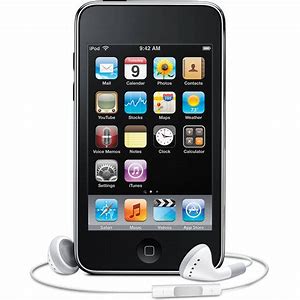
Manage two-factor authentication from iPod touch
Two-factor authentication helps prevent others from accessing your Apple ID account, even if they know your Apple ID password. Two-factor authentication is built into iOS 9, iPadOS 13, OS X 10.11, or later.
Certain features in iOS, iPadOS, and macOS require the security of two-factor authentication, which is designed to protect your information. If you create a new Apple ID on a device with iOS 13.4, iPadOS 13.4, macOS 10.15.4, or later, your account automatically uses two-factor authentication. If you previously created an Apple ID account without two-factor authentication, you can turn on its extra layer of security at any time.
Note: Certain account types may be ineligible for two-factor authentication at the discretion of Apple. Two-factor authentication isn’t available in all countries or regions. See the Apple Support article Availability of two-factor authentication for Apple ID.
For information about how two-factor authentication works, see the Apple Support article Two-factor authentication for Apple ID.
Turn on two-factor authentication
- If your Apple ID account isn’t already using two-factor authentication, go to Settings
 > [your name] > Password & Security.
> [your name] > Password & Security. - Tap Turn On Two-Factor Authentication, then tap Continue.
- Enter a trusted phone number, a phone number where you want to receive verification codes for two-factor authentication.You can choose to receive the codes by text message or automated phone call.
- Tap Next.
- Enter the verification code sent to your trusted phone number.To send or resend a verification code, tap “Didn’t get a verification code?”
You won’t be asked for a verification code again on your iPod touch unless you sign out completely, erase your iPod touch, sign in to your Apple ID account page in a web browser, or need to change your Apple ID password for security reasons.
After you turn on two-factor authentication, you have a two-week period during which you can turn it off. After that period, you can’t turn off two-factor authentication. To turn it off, open your confirmation email and click the link to return to your previous security settings. Keep in mind that turning off two-factor authentication makes your account less secure and means you can’t use features that require a higher level of security.
Note: If you use two-step verification and upgrade to iOS 13 or later, your account might be migrated to use two-factor authentication. See the Apple Support article Two-step verification for Apple ID.
Add another device as a trusted device
A trusted device is one that can be used to verify your identity by displaying a verification code from Apple when you sign in on a different device or browser. A trusted device must meet these minimum system requirements: iOS 9, iPadOS 13, or OS X 10.11.
- After you turn on two-factor authentication on one device, sign in with the same Apple ID on another device.
- When you’re asked to enter a six-digit verification code, do one of the following:
- Obtain the verification code on your iPod touch or another trusted device that’s connected to the internet: Look for a notification on that device, then tap or click Allow to make the code appear on that device. (A trusted device is an iPhone, iPad, iPod touch, or Mac on which you’ve already turned on two-factor authentication and on which you’re signed in with your Apple ID.)
- Obtain the verification at a trusted phone number: If a trusted device isn’t available, tap “Didn’t get a verification code?” then choose a phone number.
- Obtain the verification code on a trusted device that’s offline: On a trusted iPhone, iPad, or iPod touch, go to Settings > [your name] > Password & Security, then tap Get Verification Code. On a trusted Mac with macOS 10.15 or later, choose Apple menu
 > System Preferences > Apple ID > Password & Security, then click Get Verification Code. On a trusted Mac with macOS 10.14 and earlier, choose Apple menu > System Preferences > iCloud > Account Details > Security, then click Get Verification Code.
> System Preferences > Apple ID > Password & Security, then click Get Verification Code. On a trusted Mac with macOS 10.14 and earlier, choose Apple menu > System Preferences > iCloud > Account Details > Security, then click Get Verification Code.
- Enter the verification code on the new device.You won’t be asked for a verification code again unless you sign out completely, erase your device, sign in to your Apple ID account page in a web browser, or need to change your Apple ID password for security reasons.
Add or remove a trusted phone number
When you enrolled in two-factor authentication, you had to verify one trusted phone number. You should also consider adding other phone numbers you can access, such as a home phone, or a number used by a family member or close friend.
- Go to Settings
 > [your name] > Password & Security.
> [your name] > Password & Security. - Tap Edit (above the list of trusted phone numbers), then do one of the following:
- Add a number: Tap Add a Trusted Phone Number.
- Remove a number: Tap
 next to the phone number.
next to the phone number.
Trusted phone numbers don’t automatically receive verification codes. If you can’t access any trusted devices when setting up a new device for two-factor authentication, tap “Didn’t get a verification code?” on the new device, then choose one of your trusted phone numbers to receive the verification code.
View or remove trusted devices
- Go to Settings
 > [your name].A list of the devices associated with your Apple ID appears near the bottom of the screen.
> [your name].A list of the devices associated with your Apple ID appears near the bottom of the screen. - To see if a listed device is trusted, tap it, then look for “This device is trusted and can receive Apple ID verification codes.”
- To remove a device, tap it, then tap Remove from Account.Removing a trusted device ensures that it can no longer display verification codes and that access to iCloud (and other Apple services on the device) is blocked until you sign in again with two-factor authentication.
Generate a password for an app that signs in to your Apple ID account
With two-factor authentication, you need an app-specific password to sign in to your Apple ID account from a third-party app or service—such as an email, contacts, or calendar app. After you generate the app-specific password, use it to sign in to your Apple ID account from the app and access the information you store in iCloud.
- Sign in to your Apple ID account.
- Tap Generate Password (below App-Specific Passwords).
- Follow the onscreen instructions.
After you generate your app-specific password, enter or paste it into the password field of the app as you would normally.
For more information, see the Apple Support article Using app-specific passwords.
